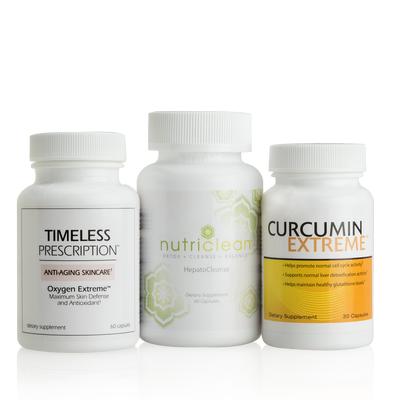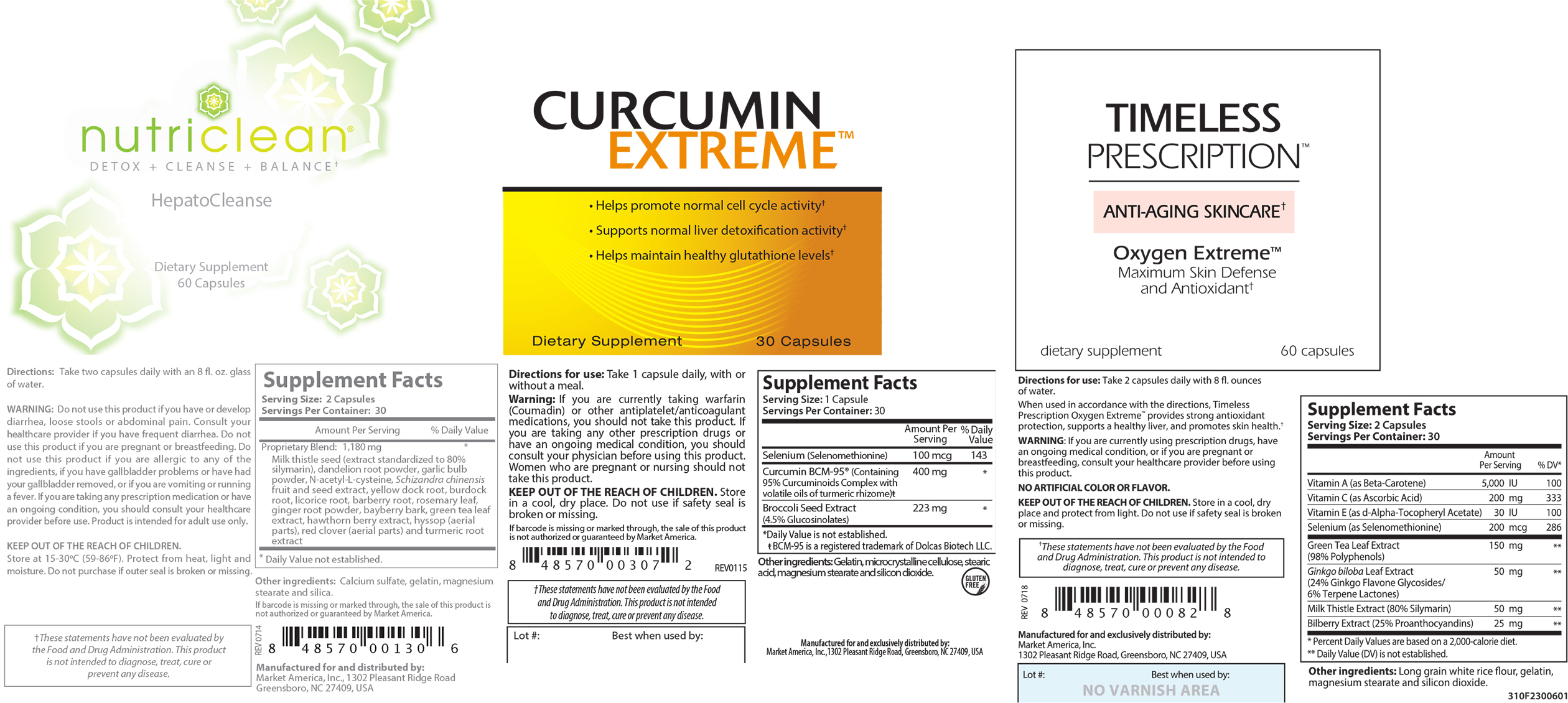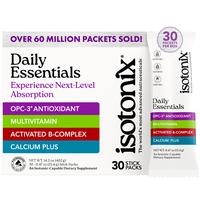Detoxify, wind down and rejuvenate.

Complete Detoxification Kit
sku 6487
$109.95
$ 2.20 Cashback
This product qualifies for free or reduced cost shipping. Learn More
Benefits
- Save money compared to purchasing these products separately!
- Supports a healthy liver
- Supports the body’s natural ability to produce detoxification enzymes, which scavenge harmful toxins in the body
- Helps to cleanse and detoxify the liver and blood
- Helps excrete toxins that accumulate over time
- Provides strong antioxidant protection and protects the body from the negative effects of free radicals
- Supports healthy immune function
- Promotes apoptosis in unhealthy cells
- Helps maintain healthy glutathione levels
- Supports normal glutathione synthesis
Product Classifications
Gluten-Free - The finished product contains no detectable gluten (<10ppm gluten)
Quality Standards - GMP Operations and Standardized Ingredients
Checked For: Heavy Metals, Microbiological Contaminants, Allergens, Residual Solvents, Potency, Purity and Identity
Why Choose The Complete Detoxification Kit?

Toxins build up in our bodies over time through the air we breathe, the foods we eat and the stress we put our bodies under on a daily basis. The master filter in our body – the liver – works to cleanse the body of these toxins to keep them from disrupting the normal functions and operations of the body; essentially, keeping you healthy.
Unfortunately, the overabundance of toxins our bodies build up, causes undue stress on our liver; and often the liver can’t keep up with the demand. It needs help to remove these toxins and keep you healthy.
To promote regular detoxification, Market America has created the Complete Detoxification Kit, a combination of three products – Timeless Prescription® Oxygen Extreme™, Curcumin Extreme™, and NutriClean® HepatoCleanse – that work synergistically to support overall liver health, promote normal cleansing and detoxification of the liver, and provide antioxidant support to keep your body – including the liver – healthy over time. * Plus, you'll save money by purchasing the Complete Detoxification Kit instead of buying these products individually.
FAQs
Who should purchase the Complete Detoxification Kit?
Anyone over 18 years old or over can take the products contained in the Complete Detoxification Kit, especially those who want to support normal liver detoxification activity, help maintain healthy glutathione levels and provide the body with strong antioxidant protection to fight the negative effects of free radicals.
What is glutathione, and why is it important in the detoxification process?
Glutathione performs two tasks in the detoxification process. First, it quenches free radicals created when the liver neutralizes toxins in Phase 1 of detoxification. Second, it combines with toxic chemicals, such as those found in cigarette smoke, auto exhaust and the deadly PCBs, in Phase 2 of detoxification so they can be safely excreted. Glutathione also detoxifies substances in the intestines before they can be absorbed into your bloodstream. It is also thought to protect your stomach lining from the free radical effects of the high amounts of acid it produces. High glutathione levels are good for the immune system, enabling the body to produce more white blood cells to fight off infection and rid the body of harmful toxins. The products contained in the Complete Detoxification Kit have been shown to help the body generate glutathione, which is necessary to the enzymatic reactions that must take place in order for proper filtration and elimination of bodily toxins. Glutathione is also known as a Phase II enzyme in that it bonds with separate Phase I enzymes in making the filtered toxins more soluble for elimination through the bile or the kidneys.
What’s the difference between a liver detox and a weight loss detox?
Many people hear “detox” and immediately think of “weight loss.” While it is common for those starting a weight loss program to go through a period of detoxification, they do so for different reasons. A weight loss detox, which is recommended once or twice a year, usually lasts for periods between three and seven days and involves eating only certain foods, in addition to using products such as NutriClean® 7-Day Cleaning System — a colon and liver cleansing system — to detoxify and cleanse the digestive tract and liver to support the body’s natural processes of restoration and cleansing. The Complete Detoxification Kit is meant to be used to support the body’s normal detoxification process and does not require the types of restrictions common with a periodic detox system. This includes scavenging free radicals on an ongoing basis to rid the body of toxins that build up, providing a strong, lasting antioxidant defense to keep toxins from accumulating, and maintaining your liver health, which helps cleanse the body on a regular basis and not just for a short period of time.
Why is the liver so important?
The liver is one of the most important organs in the body. It is the way the body eliminates many unnatural, detrimental substances that enter the body on a consistent basis. Maintaining optimal liver health is a must in modern times where free radicals, toxins and harmful chemicals bombard the body daily. The liver's function is to sort out and eliminate all of these harmful substances, removing them from the body. The body regularly does this to stay healthy and, more importantly, alive. Internally, the liver must break down compounds, such as excess hormones and other byproducts of a healthy metabolism. Externally, the liver must filter and eliminate foods, food preservatives and added chemicals, pollutants, pathogenic toxins and excessive alcohol. Lifestyle factors that we may or may not be able to control, such as genetics, diet, environment and stress can influence the proper functioning of the liver, resulting in less than optimal elimination and filtering of subsequent toxins.
How to take the Complete Detoxification Kit?
Morning:
- HepatoCleanse - 2 capsules with 8 ounces of water
- Oxygen Extreme - 2 capsules
Evening:
- Curcumin - 1 capsule with or without food
Ingredients
Timeless Prescription® Oxygen Extreme™:
Vitamin A (Beta-Carotene) 5000 IU
Vitamin A is
an anti-aging micronutrient of the highest order, standing firmly alongside
vitamins C, E and the mineral selenium in its ability to help maintain health.
Vitamin C 200 mg
Also called ascorbic acid,
vitamin C helps to maintain healthy collagen in the skin, promotes normal
healing, promotes healthy teeth and bones, and supports the immune system.
Vitamin E 30 IU
Vitamin E supports the respiratory
system. It also promotes a healthy immune system. Vitamin E protects the body
from oxidation, a normal aging process by which oxygen breaks down the body’s
tissues.
Selenium 200 mcg
Selenium is one of the most
important micronutrients to include in a longevity-minded health regimen and is
frequently cited by anti-aging specialists as an antioxidant that should be
included on an anti-aging checklist.
Bilberry 25 mg
Bilberry’s chief action as an
antioxidant is its powerful synergy with vitamin E. On the most basic level, it
supports the normal resistance of blood capillaries and promotes their
impermeable nature.
Green Tea Extract 300 mg
Green tea extract is a
health-promoting antioxidant. It is rich in polyphenols that have been shown to
promote health.
Ginkgo Biloba 50 mg
Ginkgo biloba helps to
support memory, brain function, mood, cerebral and peripheral circulation, and
oxygenation and blood flow.
Milk Thistle 50 mg
Milk thistle is used to
promote liver health. Contains some of the most potent liver-supporting
substances known. Protects against free radicals by acting as an antioxidant,
protecting the liver. Supports the normal production of new liver cells.
Curcumin Extreme™:
Curcumin (BCM-95®) 400 mg
Scientists have long
been aware of the wide array of health benefits from the Indian spice turmeric,
which is a source of the active phytochemical curcumin.
Broccoli Seed Extract (6% Sulphoraphane Glucosinolates)
167 mg
The health benefits and protective properties of broccoli and
other cruciferous vegetables have been well documented over the past 25 years.
Broccoli seed extract is a powerful source of sulphoraphane glucosinolates.
Selenium (Selenomethionine) 100 mcg
Selenium is
a required cofactor for selenoproteins, such as glutathione peroxidase.
Selenomethionine is incorporated directly into proteins because
selenomethionine cannot be distinguished from methionine during the translation
of mRNA into protein.
NutriClean® HepatoCleanse:
Milk Thistle Seed (extract standardized to 80%
silymarin)
Milk thistle promotes liver and gallbladder health by
providing free-radical scavenging activity, stimulation of liver cell
regeneration and prevention of toxin uptake by the liver cells.
N-Acetyl-L-cysteine
N-Acetyl Cysteine (NAC) is
derived from the sulfur-containing amino acid, cysteine. It is produced
naturally in the body and is found in foods. NAC mediates (along with glutamic
acid and glycine) the conversion of cysteine into glutathione.
Dandelion Root
The dandelion, the common
stubborn plant of many front lawns, is an unusually nutritious food. Its leaves
contain substantial amounts of vitamin A, as well as moderate amounts of
vitamin D, vitamin C, various B vitamins, iron, silicon, magnesium, zinc and
manganese.
Garlic Bulb
Garlic was used in China as early as
A.D. 510. Louis Pasteur studied the antibacterial action of garlic in 1858.
These days it is largely used because it exerts a positive effect on the
cardiovascular system.
Hawthorn Berry Extract
Hawthorn, or Crataegus
oxyacantha, grows as a thorny shrub with white or pink flowers and berries that
resemble miniature apples. This shrub is native to northern temperate climates
in Asia, Europe and eastern North America.
Schizandra Chinensis Fruit and Seed
Extract
Schizandra has an extensive history in ancient Chinese
medicine as an herb promoting general well-being and vitality. Schizandra
originates from the red berries that grow on a vine-like plant belonging to the
magnolia family.
Yellow Dock Root
Yellow dock is related to the
buckwheat family that is native to northern Europe and Asia, but its ability to
adjust to various climates has allowed it to spread to many parts of the world.
Burdock Root
Burdock is a well-respected
medicinal herb. It was used to support healthy joints and a healthy digestive
system. Burdock root also contains high amounts of inulin and mucilage.
Licorice Root
Licorice root has long been used
in both foods and medicine. In Chinese medicine, licorice is an ingredient in
nearly all herbal formulas. Among its most prominent uses are as a demulcent
(soothing, coating agent) in the digestive and urinary tracts.
Barberry Bark and Root
Barberry has been used
extensively throughout the world for its healing properties. Berberine is
isolated from the roots and bark of Berberis vulgaris.
Rosemary Leaf
Herbalists have long used rosemary
as an energy booster for the elderly and to help with indigestion. In China its
used for head discomfort. Rosemary has been used to support a healthy appetite,
healthy blood pressure, liver and gallbladder.
Ginger Root
Ginger is a shoot-like plant with a
single, purple-green flower that contains a thick root from which uses for this
plant originate. It is native to coastal India, but it now grows and is
harvested in Jamaica, China, Africa and the West Indies.
Green Tea Leaf Extract
Green tea has been used
medicinally for centuries in India and China. A number of beneficial health
effects are related to regular consumption of green tea, and dried/powdered
extracts are available as a part of dietary supplements.
Hyssop (aerial parts)
The herb hyssop, also
known as Hyssop officinalis, has been used for ages in both the religious and
medical arenas. A two-foot high evergreen shrub with dark blue flowers, hyssop
grows naturally throughout the Mediterranean region but is also cultivated
elsewhere.
Red Clover Flower
Red clover is a member of the
legume (bean) family - the same class of plants as chickpeas and soybeans. Red
clover was, and is, considered one of the premier purifying herbs for the
blood.
Turmeric Root Extract
Turmeric is part of the
ginger family. Its stalk is used in both food and medicine, creating the common
yellow ingredient that colors and adds flavor to curry. In traditional Indian
Ayurveda, turmeric is thought to support general body strength, vision and
stimulate milk secretion.
Reviews
Displaying 1 - 3 of 3
01/03/2025
by GeneviaC
Amazing Trio
Fantastic products with the perfect ingredients! Love, love, love this trio
Response from Customer Service
01/03/2025
Thank you for your enthusiastic review of the Complete Detoxification Kit! We're thrilled to hear that you find the products and their ingredients fantastic. Your love for the trio truly brightens our day. Thank you for choosing our detoxification kit and sharing your positive experience with us!
04/12/2021
by jinmingc
I would like to know
Which one to eat in the morning and which one to eat at night
Response from Customer Service
04/13/2021
Dear Valued Customer,
Thank you for taking the time to share your thoughts on the Complete Detoxification Kit! The directions for the HepatoCleanse and Oxygen Extreme capsules state to take two with 8oz of water. The Curcumin directions state to take one capsule daily with or without a meal. Individual label directions can be found on each product label.
Thank you again!
The Product Information Team
10/10/2020
by DORTHEAW
My product review
i have been taking these products intermittently for over a year. my labs have been great and I have been feeling good.
Response from Customer Service
10/10/2020
Dear Valued Customer,
Thank you for taking the time to share your thoughts on the Complete Detoxification Kit! We are happy to hear you are pleased with the products.
Thank you again!
The Product Information Team


